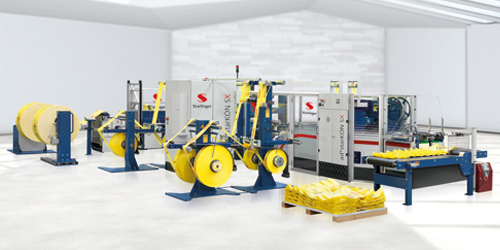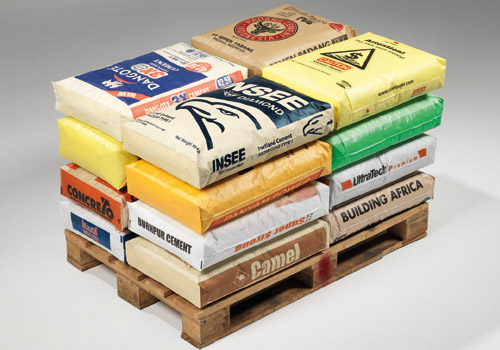
In quite some cases plastic packaging is more environmentally friendly than other materials. A recent study shows that plastic sacks are the most sustainable packaging solution for cement: AD*STAR® cement sacks made of coated polypropylene fabric achieve considerably better results than sacks made of paper or recycled polypropylene tape fabric.
The effects on the environment, a much discussed topic regarding plastic bags for everyday use, also play an increasingly important role for industrial packaging. A new study which compares different types of cement packaging now proves that woven plastic packaging is the most environmentally friendly solution for this application. The results of the life-cycle-analysis, carried out by the German PE INTERNATIONAL AG (now thinkstep AG) and commissioned by Starlinger & Co. Ges.m.b.H., clearly show that AD*STAR® sacks – welded block bottom valve sacks made of coated polypropylene tape fabric – have lower global warming potential (also known as carbon footprint) than paper sacks or sewn PP sacks which are widely used especially in Asia. For comparison, sewn sacks made in China as well as kraft paper sacks made in Saudi Arabia were analysed; all sacks had a filling capacity of 50 kg cement. The results are clear: The AD*STAR® sacks developed by Starlinger do not only show the lowest values regarding global warming potential, they are also the most environmentally friendly packaging in terms of acidification potential (acid rain), ozone depletion potential, photochemical ozone creation potential (causes summer smog), as well as energy and fresh water consumption.
Low breakage rates – smaller CO2 equivalent
A decisive factor for the positive results of AD*STAR® sacks are the low breakage rates in the course of the life cycle of the sacks. For the production of the AD*STAR® sacks analysed in the study, 100 % virgin material was used both in China and Saudi Arabia. Due to the special production process AD*STAR® sacks are extremely robust despite their very low weight. The strength and resistance results in breakage rates below 1 % in the entire life-cycle, while paper bags and sewn sacks have breakage rates between 2.3 % and 4.4 %. This means that if AD*STAR® sacks are used, less cement is lost and must be replaced, and less packaging is needed – consequently, less greenhouse gases are produced.
Great savings potential for greenhouse gases
 The study analyses the environmental impact of the sacks during their entire life-cycle – from raw material to the disposal of the sack. Raw material production, sack production, filling, transport and storage until disposal – by means of landfill, recycling or thermal utilisation – were analysed. Starlinger has commissioned the study with comparable products from China and Saudi Arabia because the type of cement packaging analysed forms the biggest share on the cement market in the respective country.
The study analyses the environmental impact of the sacks during their entire life-cycle – from raw material to the disposal of the sack. Raw material production, sack production, filling, transport and storage until disposal – by means of landfill, recycling or thermal utilisation – were analysed. Starlinger has commissioned the study with comparable products from China and Saudi Arabia because the type of cement packaging analysed forms the biggest share on the cement market in the respective country.
In China, the world’s biggest cement producer, around 20 billion sewn cement sacks made of polypropylene tape fabric with recycled content are produced. In the study, sacks made of 50 % virgin material mixed with 50 % recycled material, and sacks made of 100 % recycled material were analysed. The quality of the sacks is comparatively low because the recycled material used to produce the sacks is in most cases severely degenerated, i.e. the necessary level of strength can only be achieved by increasing the fabric weight. In addition, the sewing process further weakens the material by up to 50 %. Sewn cement sacks have significantly higher breakage rates and thus cause considerable cement loss which has to be compensated by additional production. Changing over to AD*STAR® sacks does not only reduce CO2 emissions caused during production and relieve the environment, it also helps to automatize the entire cement filling and transporting chain – a process that is already underway considering the current investments in modern equipment on the Chinese cement sector.
In Saudi Arabia, one of the biggest producers and exporters of plastic granulates worldwide, imported paper is used for cement packaging. Thus, two- and three-layer kraft paper cement sacks were analysed in the study. In this case, switching over to the more robust AD*STAR® sacks would not only prevent the loss of countless tons of cement caused by sack rupture, but also greatly reduce raw material input for sack production and avoid long transport routes. In addition, the entire value created by both raw material and sack production would remain within the country.
More than 7.5 billion sacks per year worldwide
The worldwide used AD*STAR® sacks have been developed and patented by Starlinger. Today, more than 7.5 billion AD*STAR® sacks are produced on Starlinger machinery.

